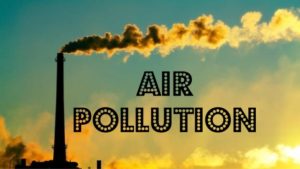It is pathetic to know that more than 9 out of 10 people worldwide live in areas with excessive air pollution, contributing to strokes, heart disease, lung cancer and other problems, says WHO Report on Ambient Air Pollution 2016.
About WHO’s Report :
The new report says that 92 percent of people live in areas where air quality exceeds WHO limits, with southeast Asia, eastern Mediterranean and western Pacific regions hardest hit.
- The report is developed by WHO in collaboration with University of Bath, U.K. based on satellite measurements, ground station monitors and air transport models in over 3,000 locations including both rural and urban areas.
- It is noted that in previous studies, the W.H.O. estimated that more than eight in 10 people in urban areas that monitored air pollution were breathing unhealthy air and that about seven million deaths a year were linked to indoor and outdoor pollution.
- Household fuels, industrial activities, pollution from transports, burning of wastes and emission from coal-fired power plants are the major contributors of air pollution. Other than manmade pollution natural events like dust storms that are common in regions close to deserts contribute to air pollution as well. The new study reduced the second estimate to 6.5 million deaths.
- Turkmenistan has the highest rate of deaths per capita due to ambient air pollution in the WHO’s classification, followed by Tajikistan, Uzbekistan, Afghanistan, Egypt and China. India alone accounting for over 75 per cent of the casualties caused by cardiovascular diseases and lung cancer.
- The aim is to educate both policymakers and individuals about the risks, at a time of spiraling health care costs. Dora noted, for example, that doctors could advise their patients about higher risks of heart disease in some countries, or how solar lamps could substitute for kerosene lamps that are used in many parts of the developing world.
- North America is faring well compared with Europe, mostly due to Europe’s greater dependence on diesel fuel and partially due to farm policies that generate agricultural ammonia and methane.
- The three Indian cities, New Delhi, Mumbai and Kolkata, are in the list of 11 most-polluted mega cities, the most for any country. China has only 2 cities in the top 10 list.
About Air pollution :
Air pollution is the introduction of particulates, biological molecules, or other harmful materials into Earth’s atmosphere, causing diseases, allergies, death to humans, damage to other living organisms such as animals and food crops, or the natural or built environment. Air pollution may come from anthropogenic or natural sources.
- The atmosphere is a complex natural gaseous system that is essential to support life on plane tEarth.
- Indoor air pollution and urban air quality are listed as two of the world’s worst toxic pollution problems in the 2008 Blacksmith Institute World’s Worst Polluted Places report. According to the 2014 WHO report, air pollution in 2012 caused the deaths of around 7 million people worldwide, an estimate roughly matched by the International Energy Agency.

- An air pollutant is a substance in the air that can have adverse effects on humans and the ecosystem. The substance can be solid particles, liquid droplets, or gases. A pollutant can be of natural origin or man-made.
- Pollutants are classified as primary or secondary. Primary pollutants are usually produced from a process, such as ash from a volcanic eruption. Other examples includecarbon monoxide gas from motor vehicle exhaust, or the sulfur dioxide released from factories. Secondary pollutants are not emitted directly.
- Rather, they form in the air when primary pollutants react or interact.Ground level ozone is a prominent example of a secondary pollutant. Some pollutants may be both primary and secondary: they are both emitted directly and formed from other primary pollutants.
- A lack of ventilation indoors concentrates air pollution where people often spend the majority of their time. Radon (Rn) gas, acarcinogen, is exuded from the Earth in certain locations and trapped inside houses.
- Building materials including carpeting and plywood emit formaldehyde (H2CO) gas. Paint and solvents give off volatile organic compounds (VOCs) as they dry. Lead paint can degenerate into dust and be inhaled.
- Intentional air pollution is introduced with the use ofair fresheners, incense, and other scented items. Controlled wood fires in stoves and fireplaces can add significant amounts of smoke particulates into the air, inside and out. Indoor pollution fatalities may be caused by using pesticides and other chemical sprays indoors without proper ventilation.
- Air pollution is a significant risk factor for a number of pollution-related diseases and health conditions including respiratory infections, heart disease, COPD, stroke and lung cancer.
- The health effects caused by air pollution may include difficulty in breathing, wheezing, coughing,asthma and worsening of existing respiratory and cardiac conditions. These effects can result in increased medication use, increased doctor or emergency room visits, more hospital admissions and premature death.
- The human health effects of poor air quality are far reaching, but principally affect the body’s respiratory system and the cardiovascular system. Individual reactions to air pollutants depend on the type of pollutant a person is exposed to, the degree of exposure, and the individual’s health status and genetics.
- The most common sources of air pollution include particulates, ozone, nitrogen dioxide, and sulphur dioxide. Children aged less than five years that live in developing countries are the most vulnerable population in terms of total deaths attributable to indoor and outdoor air pollution
WHO :
- Headquarters: Geneva, Switzerland
- Founded: April 7, 1948
- Head: Margaret Chan





